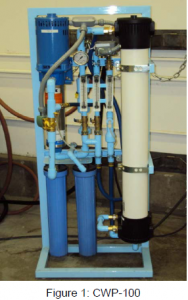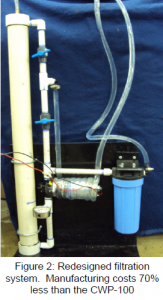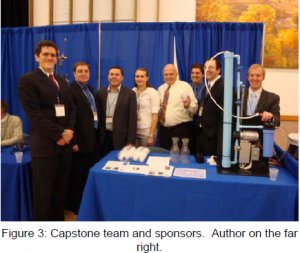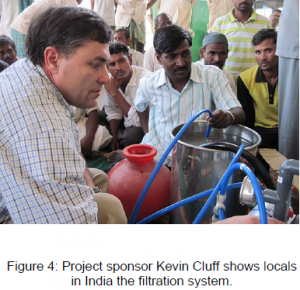Christopher Welton and Professor Perry Carter, School of Technology
Introduction
Approximately 70 million people in rural India do not have access to clean water. Chemicals such as cesium, arsenic, and others contaminate India’s drinking water, rendering it unsafe. Biological contaminates pose increased health risks to those drinking the water. If a water source is bad, large populations need to relocate to find a better source of water. Creating an economic water filtration system capable of being obtained through a micro-loan is beginning alleviate this problem. By creating an affordable and quality system, clean water is becoming a reality for the world’s poor, especially in Third World countries. Through my efforts and the efforts of my Mechanical Engineering Capstone team, we are beginning to change the situation in which countless people find themselves today. Thanks in part to the ORCA grant I received, we were able to design and manufacture three economical water filtration systems. Our designs were then handed to H2O for Humanity, a nonprofit organization that plans on producing and distributing our system in the developing world, starting in India.

The funding I received through the ORCA grant was used to compensate my team and me for the time we spent working on the project. I gave $100 to each member of our team, totaling $500 dollars. I kept the remaining $1000 dollars to compensate my time on the project as well. You’ll notice the disparity in the amount of money I kept and the amount of money I gave away, but my altruism only extended so far. Nonetheless, the grant money was welcomed by all, and I noticed an increase in our focus and productivity in our efforts to progress our project and see it to a successful conclusion.
In September 2009 I was assigned to a Mechanical Engineering Capstone team, and with that team we bid on a project to redesign a water filtration system to be marketable to the developing world. We were provided a commercial filtration system by our project sponsor, Clean Water Products. The design challenge was to redesign the CWP-100 (see figure 1) into a unit that could be manufactured for 67% less than the manufacturing costŧ of the CWP-100. (ŧBecause the component and manufacturing costs are proprietary information of Clean Water Products and its humanitarian wing, H20 for Humanity, they will not be included in this report.)

By analyzing the CWP-100 system our team was able to see that many of the components used were either too robust or too expensive for our application. One of our main targets was to provide 5 gallons of clean water for $0.01, a goal that the original system did not meet. As a team we divided the system into its main components: frame/support system, pump system, controls system, etc., and analyzed potential cost savings in each component in an effort to bring down the cost of the entire unit.

Very early on we were instructed that we would need to use a reverse osmosis (RO) membrane. Part of the patent established by Clean Water Products uses a device called a catalytic conditioner which works in conjunction with a RO membrane to prevent the membrane from scaling and restricting water flow. This was both a blessing and a curse because it forced us to focus on a certain filtration type, but kept us from exploring other options and having 100% control over our project.
We decided to scale back overall flow of our filtration system from 3 gal/min (CWP-100) to .67 gal/min because it allowed us to use less powerful (and more economical) components which therefore allowed us to meet our cost/unit and cost/gallon goals. At .67 gal/min we could produce almost 1000 gallons/day. We also decided to use a 12V DC pump instead of the CWP-100’s 120V AC pump. Our main motivation here was that such a pump could be run on a car battery, or on the provided AC-to-DC converter. Because the power supply is sometimes intermittent in the developing world, we wanted to give our end-user the option of using a battery should the power-grid fail.
Ultimately we were successful in meeting all of our goals and metrics. We developed a functioning and reliable system that filtered water with 1500ppm impurity to around 300ppm impurity (World Health Organization standard is <600ppm). Our system was also cheap enough to be affordable through micro-loan which could be paid off easily by the owner/operator through selling the water produced by our system. We also brought clean water to many who have never had clean drinking water. While our project is still in its infancy, the three units we produced were successfully implemented in India by our project sponsor. He reported our efforts were well received, and that it was one of the most spiritual experiences of his life.

This project was made possible in part through the grant I received from ORCA.
